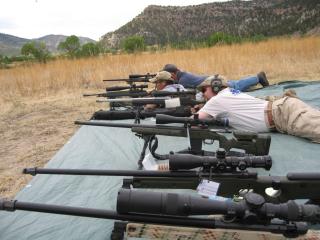
 There are many rifles which will get the job done to 1000 yards. Three of these are based on a
Remington 700, two Accuracy International, one M1A.
Rifles
Basic / Economy. On the basic end are factory rifles like the Savage 10FP and Remington 700
PSS. These are sporter rifles with heavy barrels and target-style stocks. Their triggers need
adjustment and/or tuning for a nice 2-4# break, and they need a scope base installed. Most of these
rifles will shoot better than 1 MOA with some factory match ammunition, but a few will be lemons.
The most likely problems will be poor ergonomic fit due to stock design. All the problems can be
fixed with money spent replacing the stock, adding a detachable box magazine, adding a good
trigger, replacing the barrel with a premium match barrel, getting the action trued, etc. You
should be able to get a 10FP or 700 PSS for under $700, then add a base and rings, a scope and a
bipod.
Custom. There are many gunsmiths who build precision long-range rifles. The vast majority of
these are based on the Remington 700 action, with real performance improvements done to them, and
some frills. Some are based on better actions such as the Surgeon, which has a Picatinny rail
machined right into the top of the receiver. The builders I recommend are GA Precision, KMW
Precision, and Surgeon Rifles. These guys all have impeccable records and deliver a lot of
well-built rifles for practical long-range shooting.

 Factory sniper rifles from Accuracy International and Sako are good-to-go from the box.
The advantage of one of these over the
high-end factory rifles (listed next) is that you can get it made exactly to your specs. Expect to
pay $3000-4500 for one of these rifles.
High-end Factory. The other option is a high-end factory rifle. These are generally rifles
designed from the ground up for military sniper duty, and sold on the commercial market as well.
The most notable are the Arctic Warfare line from Accuracy International (U.K.), and the TRG line
from Sako (Finland). The quality and accuracy of these rifles are basically the same as the custom
rifles mentioned, but they are factory pieces and generally have a "system" of accessories to go
along with them, as well as having a logistics trail already. Replacement
parts are stocked items, not custom one-offs. $3000-5500.
Most new long-range rifle shooters will be able to shoot a long time and learn a lot using the basic
Remington 700 or Savage 10FP, if they get the rifle to fit them and mount quality optics on it. For
the shooter that never wants to question if his equipment has let him down, the AI AW, Sako TRG, or
high-end custom rifle from GAP, KMW, or Surgeon is the way to go. Putting more money in a better
rifle is an investment that will pay off down the line.
Ammunition
There are basically two choices. You can buy factory ammunition, or you can shoot hand-loads. In
some calibers, there are no really good factory loads appropriate for long-range shooting, so you
effectively have to reload.
The best sources of factory ammunition for long-range shooting are: the Gold Medal Match line from
Federal, and Black Hills Ammunition. .308 Winchester has the most factory match-grade ammunition
available, so if ammo supply will be a problem and you cannot reload, .308 is definitely the caliber
to choose.
Here is a cautionary note for .308 Winchester ammunition selection for long-range use. The .308 can
deliver good thousand-yard performance, but only with careful selection of ammunition, specifically
the bullet used and the muzzle velocity. Those two together must be sufficient to keep the bullet
solidly supersonic when shot through the current ambient atmospheric conditions. Specifically,
standard 150gr FMJ and even some match bullets have BC values too low to reliably stay supersonic
at this range. In denser atmospheric conditions, they may produce poor accuracy or even strike the
target sideways. The 168gr SMK bullet is known for producing variable results at 1000 yards. There
are better choices for .308 bullet selection, so just don't use the 168gr SMK. The Sierra MatchKing
bullets heavier than 175gr will work. Any of the Berger VLD bullets heavier than 168gr should work.
The best choice is the 155gr Lapua Scenar, if it shoots accurately from your barrel. This bullet
has a BC value as high as the 175gr SMK, but can be shot 100-200fps faster from most barrels.
Reloading is financially compelling. Where factory match might be $18 a box of 20, by saving your
brass and reloading, you can save 50-75% of the cost. That translates into more shooting for less
money. The other benefit is that you can tailor a load for your specific rifle that suits your
needs.
There are some excellent long-range calibers for which factory match-grade long-range ammunition is
not available, or is available only in very small quantities or for a very high price. These
include all of the calibers discussed above except for .308, 300 WM, and .338 Lapua. If you
own a rifle in a caliber for which good long-range ammunition is not available, you have committed
to quite a bit of load development and reloading time.
When given a choice in components, I recommend choosing Lapua cases (brass) if they are available in
that caliber. After Lapua, try Norma, then Winchester, then whatever you can get. Bullet selection
was covered before, but some good candidates are bullets from Lapua, Berger, and Sierra. For powder
type, I prefer to use powers from Hodgdon's "Extreme" line, including H4831SC, Varget, Retumbo.
There is always some experimentation involved in developing "THE" load for your long-range rifle.
|